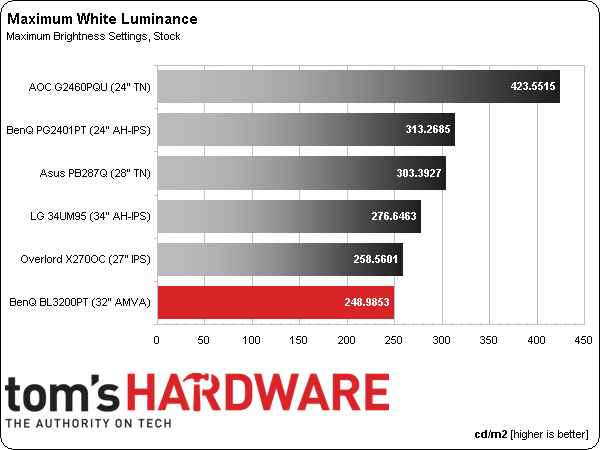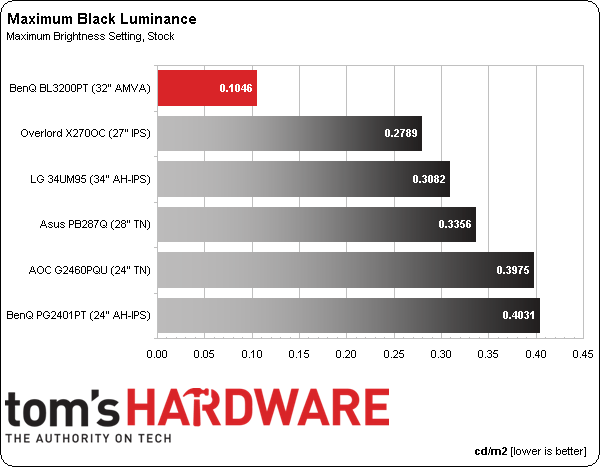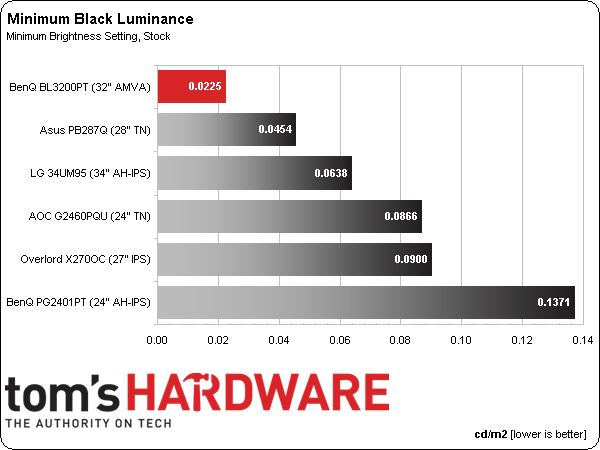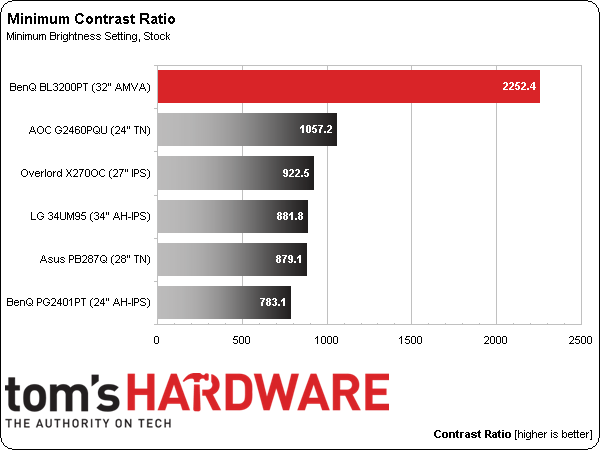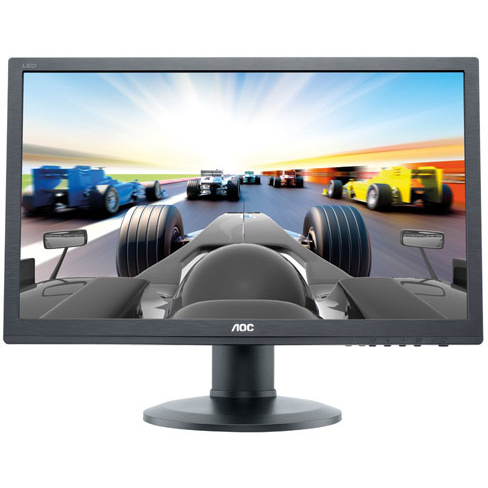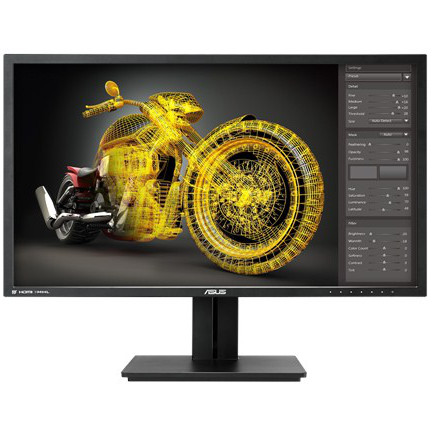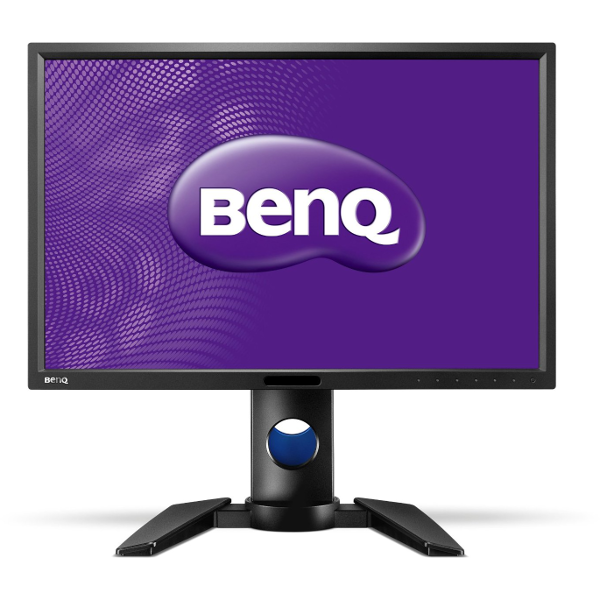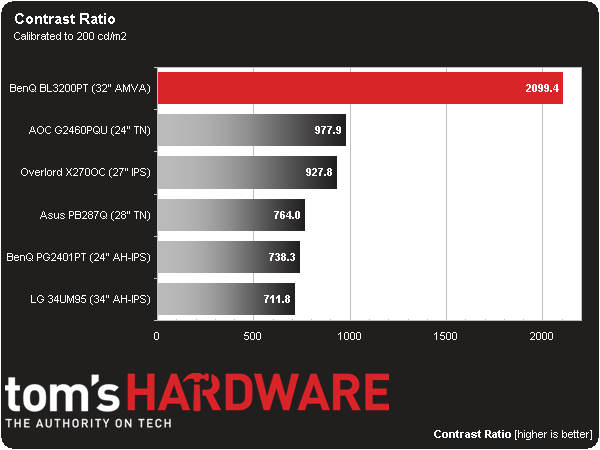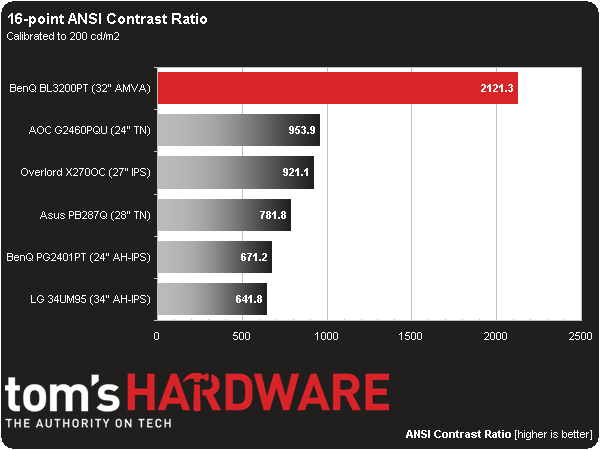BenQ BL3200PT Review: A 32-Inch AMVA Monitor At 2560x1440
The extra pixel density of a 27-inch monitor sporting a native 2560x1440 resolution can make small text difficult to read. BenQ solves the problem by adding five extra inches to its BL3200PT. Today we test this jumbo 32-inch AMVA-based panel in our lab.
Results: Brightness and Contrast
Uncalibrated
Before calibrating any panel, we measure zero and 100-percent signals at both ends of the brightness control range. This shows us how contrast is affected at the extremes of a monitor's luminance capability. We do not increase contrast control past the clipping point. While that'd increase a monitor’s light output, the brightest signal levels would not be visible, resulting in crushed highlight detail. Our numbers show the maximum light level possible with no clipping of the signal.
BenQ specs the BL3200PT at 300 cd/m2 max output. But we could only get to 248.9853 cd/m2 with the Contrast control on 50. Increasing it clips detail and shifts the color of brighter image elements towards green. When a monitor is this large, however, anything over 200 cd/m2 still looks suitably bright.
AMVA technology promises better black levels and contrast than IPS, and this display certainly delivers. With the backlight on maximum, BenQ lays waste to the rest of the group. In fact, a .1046 cd/m2 result is better than many HDTVs.
Despite its lower white level, the BL3200PT offers max contrast that’s almost double the second-place X270OC, putting it far ahead of any IPS screen we’ve tested and almost all of the TN monitors too.
We believe 50 cd/m2 is a practical minimum standard for screen brightness. Any lower and you risk eyestrain and fatigue. The XL2720Z bottoms out right at 50.5889 cd/m2. This is a great light level for playing games or working in a totally darkened room. As you’ll see below, black levels and contrast hold up extremely well, too.
We’ve only seen a couple of other displays measure darker than the BL3200PT, and they had correspondingly lower minimum white levels. Remember that the BenQ is actually practical to use at its minimum backlight setting unlike some other screens.
The resulting contrast is only a little lower than the maximum. That's the sort of consistency we always look for and appreciate from any display. No matter your brightness preference, you’ll always see a contrast ratio of around 2200 to 1.
Get Tom's Hardware's best news and in-depth reviews, straight to your inbox.
After Calibration
Since we consider 200 cd/m2 to be an ideal point for peak output, we calibrate all of our test monitors to that value. In a room with some ambient light (like an office), this brightness level provides a sharp, punchy image with maximum detail and minimum eye fatigue. On many monitors, it’s also the sweet spot for gamma and grayscale tracking, which we'll look at on the next page.
In a darkened room, many professionals prefer a 120 cd/m2 calibration. We have found this makes little to no difference on the calibrated black level and contrast measurements.
The black level doesn’t suffer one bit after calibration. It’s less than half of the second-place AOC G2460PQU. AMVA panel technology seems to surpass the excellent dark-image performance of TN, while offering better off-axis viewing performance. It’s a win-win in our opinion.
The calibrated contrast ratio is solidly over 2000 to 1, which is excellent. We’re still hoping to see HDTV-level contrast in computer monitors someday, and the BL3200PT takes a huge step towards that goal. While AMVA is unlikely to ever match plasma or OLED in the black-level department, it’s emerging as the best LCD tech so far (at least in this discipline).
ANSI Contrast Ratio
Another important measure of contrast is ANSI. To perform this test, a checkerboard pattern of sixteen zero and 100-percent squares is measured, yielding a somewhat more real-world metric than on/off readings because we see a display’s ability to simultaneously maintain both low black and full white levels, factoring in screen uniformity, too. The average of the eight full-white measurements is divided by the average of the eight full-black measurements to arrive at the ANSI result.
We’ve seen feedback on early AMVA panels talking about poor uniformity and light bleed. Obviously, our sample does not suffer from those maladies. In fact, this is the first time we’ve seen a display’s ANSI result exceed its calibrated outcome, demonstrating excellent quality control on the parts of BenQ and AU Optronics.
Current page: Results: Brightness and Contrast
Prev Page Measurement and Calibration Methodology: How We Test Next Page Results: Grayscale Tracking and Gamma Response
Christian Eberle is a Contributing Editor for Tom's Hardware US. He's a veteran reviewer of A/V equipment, specializing in monitors. Christian began his obsession with tech when he built his first PC in 1991, a 286 running DOS 3.0 at a blazing 12MHz. In 2006, he undertook training from the Imaging Science Foundation in video calibration and testing and thus started a passion for precise imaging that persists to this day. He is also a professional musician with a degree from the New England Conservatory as a classical bassoonist which he used to good effect as a performer with the West Point Army Band from 1987 to 2013. He enjoys watching movies and listening to high-end audio in his custom-built home theater and can be seen riding trails near his home on a race-ready ICE VTX recumbent trike. Christian enjoys the endless summer in Florida where he lives with his wife and Chihuahua and plays with orchestras around the state.
-
npyrhone "Remember that 92 ppi number we mentioned at the beginning of today's story? That seems to be a sweet spot. It works fine at 24 inches if your screen is FHD. You won’t discern individual pixels, but you’ll be quickly wishing for more screen real estate. Moving up to 2560x1440 at 27 inches increases density to 109 ppi. That’s great for gaming and photo work. However, text and small objects become difficult to see for many users."Reply
I can't understand why I would need a monitor with lower pixel density? Why not just zoom the text a notch in your word processor or whatever software you are using? Of two otherwise similar monitors I would always choose the one with higher PPI, even if I used it only for word processing. -
kid-mid I rather have the 27" QNIX Evo II 1440p for $300 or the ROG Swift for $600.Reply
The days of 60Hz are almost over with.. -
moogleslam ReplyI rather have the 27" QNIX Evo II 1440p for $300 or the ROG Swift for $600.
Except that the Swift cost $800
The days of 60Hz are almost over with.. -
Merry_Blind "The only complaint we’ve registered along the way involves font size. With a pixel density of 109 ppi, text in most Windows applications becomes pretty small."Reply
That's why I don't understand people saying 1080p is crap and has to go away. I've always find that even at 1080p, the fonts are really small, and icons and interfaces in general are very tiny. In my case, it's not even a case of not being able to read, it's just that everything looks so out of place and hideous, like, Windows wasn't meant for such resolutions.
I can't imagine 1440p. Must be ridiculous to look at. It's just aesthetically not nice.
Bring on the downvotes... -
animalosity Why in God's green earth would you pay $1000 for a 1440p display at 60hz when you can get a 4K for way less than that now. Rather have UHD....Reply -
Bondfc11 I agree with npyrhone - there are ways to enlarge everything on your screen if the density is too low. Having said that - this is an interesting panel. However, I cannot wait for the days when not TNs, but also IPS and VA panels (in large formats) become standard at 120Hz. The hertz do make a noticeable difference in everything you do on the screen.Reply -
ohim I`ll wait to see what Active Sync monitors will be able to do , an IPS with Active sync over a TN with 144hz.Reply -
Merry_Blind ReplyI`ll wait to see what Active Sync monitors will be able to do , an IPS with Active sync over a TN with 144hz.
What is Active Sync? -
Merry_Blind ReplyWhy in God's green earth would you pay $1000 for a 1440p display at 60hz when you can get a 4K for way less than that now. Rather have UHD....
It's not 1000$ though...
